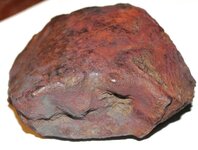johnnyi
Bronze Member
- Jul 4, 2009
- 1,887
- 144
- Detector(s) used
- minelab, white's xlt, deus xp, fisher aquanaut, white's twin box
- Primary Interest:
- Relic Hunting
Hello. I thought I'd post this for an opinion. The fact that I found it in the N.J. coastal area rich in bog iron, and the fact I found it at a late 1680's location make me almost certain it is very early smelted iron, but someone suggested to me meteorite so here goes: it is extremely heavy for its size (whichh is about five inches long) and it holds a magent tightly as though it was iron or steel. There was no apparent rust on it, only discoloration. Thanks for looking.









